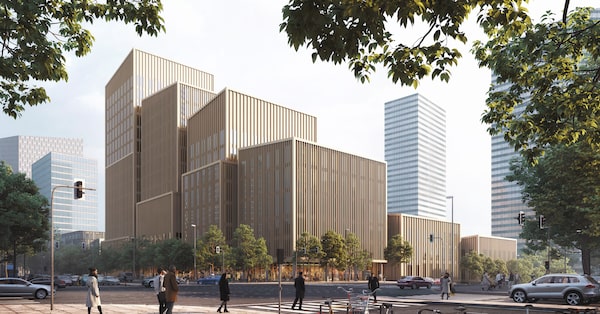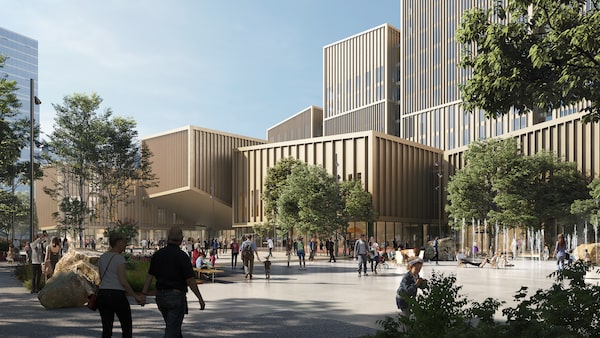
The Etobicoke Civic Centre, located at a windy site known as Six Points, in west-end Etobicoke, will be a state-of-the-art, mixed-use building of offices, a recreation centre, library, child-care centre and community meeting space.
In Toronto, a new civic centre for the west-end Etobicoke area is going up, while looking down for its heating and cooling needs.
Groundbreaking is expected to take place this March for the new Etobicoke Civic Centre, a 500,000-square-foot project that has been planned for years at a windy site known as Six Points, where Bloor Street, Dundas Street and Kipling Avenue converge.
The roads were reconfigured in 2020 to get ready for the project, which will anchor a new residential and retail area with as many as 2,700 homes, 900 of which will meet Toronto’s affordable housing criteria.
About 40,000 square feet will be commercial and retail space, mostly to serve residents and people who will work in the buildings. The Etobicoke Civic Centre, on the site of the old Westwood movie theatre, will be the hub.
This hub is a series of cubes surrounded by four small towers, the tallest to be 16 storeys. It will include a recreation centre, library, child-care centre and community meeting space, and face a new square to be used for concerts and public events.
“It’s been a long journey, and there’s still a way to go,” says David MacMillan, program manager in the environment and energy division of the City of Toronto. Envisioned by the city as long ago as 1999, the hub and neighbourhood project aim to bring people to the spaghetti-like intersection long dominated by cars.
Perhaps its biggest innovation, though, is the series of pipes that will be buried underneath the complex. The system is called geoexchange; Think of it as the heating and cooling cousin of geothermal energy.
Unlike geothermal energy, which drills pipes kilometres deep into the ground to produce electricity from deep heat, the geoexchange pipes in the new Etobicoke development are shallower, no more than 150 metres. That’s just deep enough to connect to heat pumps to draw warmth in winter and send summer heat downward to keep buildings cool, with minimal carbon emissions. The vertical pipes are connected to a network of ground loops, which circulate water or other coolant among the buildings.
“It’s a fairly novel way of heating and cooling buildings using a green technology that will help the city meet its carbon-reduction goals,” says Toronto Councillor Amber Morley, who represents Etobicoke-Lakeshore at City Hall and serves as deputy mayor for Toronto’s west end.
In 2018, the city, which owns the site, entered a partnership agreement with Enwave Energy Corp. to build the system of boreholes that will serve the heat exchange system. Enwave is known for its deep-water cooling system, which draws cold water from Lake Ontario to cool many buildings in the city’s downtown core.

A new civic square will be used for concerts and public events.Supplied
In Etobicoke, the plan is to build out the geoexchange network for the entire project, including the civic centre, high-density residential development and commercial and retail space.
Toronto has set itself a goal of reaching net-zero carbon emissions (which produce climate-changing greenhouse gases) by 2040, a full decade ahead of the net-zero national goal set by the federal government.
According to the city’s plan, called TransformTO, Toronto’s emissions have already been declining, but reaching the 2040 goal will still be a challenge as heating and cooling buildings makes up 56 per cent of the greenhouse-gas emissions in the 416 area.
There’s an imperative for cities to reduce greenhouse-gas emissions because urban emissions such as Toronto’s contribute a much larger percentage in their areas than the 18-per-cent national figure for home and building contributions.
Ms. Morley says there were a few naysayers on city council who were initially worried about the geoexchange system’s cost, but there’s now broad consensus that technology like this will help the city reach its climate-change goals.
“It’s true that there’s a larger upfront investment for this type of energy,” Ms. Morley says. “But down the road, the cost savings will be immeasurable, not only in heating and cooling but also in terms of mitigating the impacts of climate.”
She explains that it will be cost-effective in the long term because it will minimize carbon emissions that are now contributing to wild weather swings and storm damage around the world, including Toronto.
“Enwave has just completed drilling the boreholes for the system,” says Vic Gupta, chief executive officer of CreateTO, the government agency that manages the city’s real estate and is the lead developer for the project.
In December, 2023, city council awarded the contract to Multiplex Construction Canada to build the civic centre. Three architectural firms are involved: Adamson Associates Architects of Toronto, Henning Larsen Architects of Copenhagen and PMA Landscape Architects of Toronto.
“Geothermal exchange is more environmentally friendly because it uses heat from the ground [instead of natural gas],” Mr. Gupta explains. While the system relies on electricity to run, Ontario says it produces 92 per cent of its electricity from non-carbon sources (59 per cent from nuclear).
Putting together the geoexchange deal was not easy, Mr. Gupta adds.
“These [geoexchange] projects are capital-intensive. The cost upfront is higher than for a conventional heating system, and we need to leave space for heat exchangers, although we don’t need a boiler,” he says.
“Because these [sustainable] projects cost more to put together at first, they’re built on a ‘cost-avoidance’ model,” he explains.
Even though the end users (tenants and occupants) won’t have gas bills, “they’ll pay the same for heating and cooling at first, as people in conventional buildings do, so the investors can recoup their investments,” he says.
It won’t cost occupants any more money, he adds, but “they’ll know they’re doing something good for the environment.”
Ms. Morley says the Etobicoke development helps demonstrate that combatting climate change is possible.
“It’s important for the city to be leaders in environmental sustainability,” she says. “We need to show the private sector that we can develop strong, beautifully designed communities that achieve these environmental objectives.”